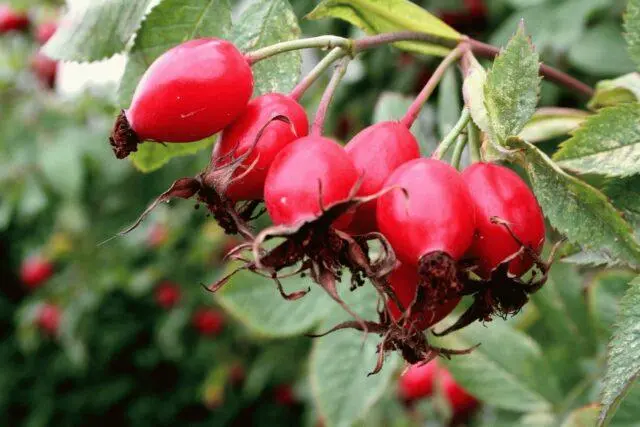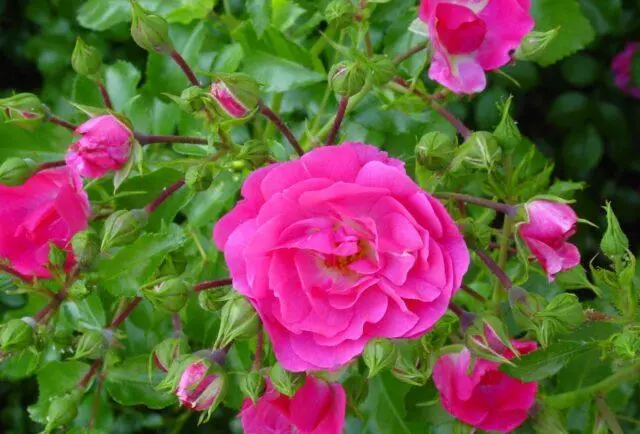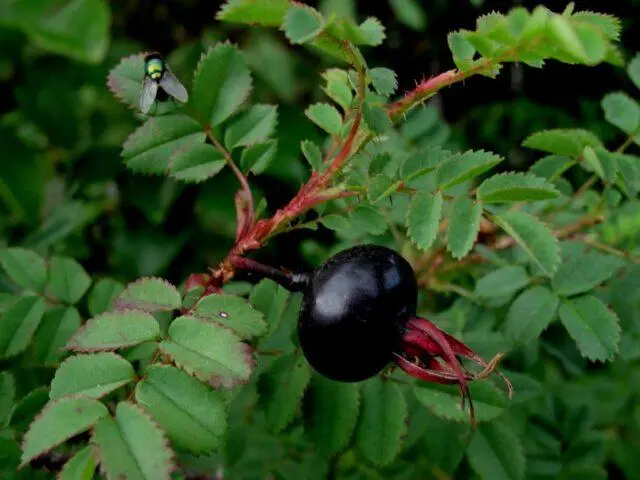Contents
Rosehip is a genus of plants that is part of the Rosaceae family and covers more than 300 species. The culture is ancient. Its fruits are very useful, they contain a large number of elements necessary for the human body, they were used for treatment even in the ice age. Cultivated varieties of wild roses are grown by gardeners on plots as ornamental plants.

Rose hips contain many vitamins and nutrients
What does a wild rose bush look like
The wild rose (Rosa eanina L.) is an unpretentious thorny shrub that is not afraid of either drought or frost. Able to grow up to 3 m in height. Depending on the growing conditions, it can live for 40-50 years, in exceptional cases longer. For example, in Germany, the oldest representative of the variety grows, which looks like a tree. This wild rose lived for about five centuries. Its height is 13 meters, and the trunk in girth is 50 cm.
The wild rose is very hardy. It has a powerful root system that goes 5-6 m deep into the ground, thanks to which it can survive even in adverse weather conditions. Rosehip branches are erect, curved down, grow very quickly. In the first year of life, they reach a height of 100 cm or more. Almost completely they are covered with very sharp, not too large thorns, which initially grow soft, and become woody in the process of aging.
The young shoots of the culture are green in color with a tinge of purple, brown, red, and the presence of bristly pubescence on their surface is possible. The leaves are medium in size, collected on branches in groups of 6-7 pieces. The flowers are not large, about 4 cm in diameter, have different shades: pink, white, yellow. At the end of the flowering period, an ovary appears in their place, then green berries, which, as they ripen, become orange or red. Sometimes you can find rose hips with black fruits.
Most often, the variety is grown as a decoration for a personal plot, used to decorate hedges. Some gardeners, knowing about the characteristics of the plant, cultivate rose hips as a food, vitamin, medicinal and honey crop. The shrub is able to grow rapidly, it is completely undemanding in care, it can be located almost anywhere in the site.
What do wild rose flowers look like
The flowering of the plant begins in late spring and continues until the last week of June. Then paniculate or corymbose inflorescences appear on its branches, most often white or pink, less often yellow, consisting of four to six buds. In diameter, they can reach 10 cm, have up to 11 petals, numerous pistils and stamens, a large corolla, can be either monocotyledonous or dicotyledonous. The opening of flowers occurs at about five in the morning, closing – closer to 20.00. During flowering, the young wild rose looks elegant and gentle, almost always exudes a pleasant fragrant aroma. Some varieties may smell specific.

Sometimes the flowers of the plant have a pronounced terry
What do rose hips look like
The appearance of rose hips is a dryish or elongated fleshy polynut with a hard peel. The berries are small, up to 15 mm in diameter. Their surface is smooth or bristly, the color is from orange to black. Inside the fruit are numerous seeds and coarse fibers. The shape and shape of the berries may be different. Found in the composition:
- vitamins A, C, PP, E, group B;
- carotene;
- iron;
- calcium;
- potassium.

The earlier the rosehip harvest, the more vitamin C it contains.
Rose hips are a berry or fruit
According to the botanical classification, the culture is a drupe-shaped fruit. Rosehip looks like a berry and, accordingly, belongs to this group. The berry characteristics of the plant exceed the fruit ones: juicy shell, bush origin, an abundance of seeds inside. But in fact, the fruit is a complex nut, because according to the characteristics of education, it is not a full-fledged berry.
Where wild rosehip grows in nature, in what places
Most often, wild rosehip grows in the forest or steppe, but it can also be seen in the undergrowth, along roads, on the edges, sandbars and near the banks of water bodies. It is found throughout the post-Soviet space and in most European regions. Initially, the culture grew in the northern hemisphere, then some species spread towards the south.
When and how fast does rosehip grow?
In addition to the fact that the rosehip shrub, the photo and description of which are presented above, is completely unpretentious in care, it still has the ability to grow rapidly. Already in the third or fourth year after planting, it forms a dense hedge. And if the plant is watered, cut and fertilized on time, then this moment can be significantly accelerated.
The culture begins to bear fruit in the second year of vegetation. Stable yields are observed at intervals of three to four years. The best results show bushes that are more than four, but less than eight years old. The timing of the ripening of the crop depends on the region of growth and weather conditions. In temperate zones, berries can be harvested from early September.

Regular shearing contributes to the rapid growth of rose hip shoots.
Conclusion
Rosehip is a unique plant that can be found in almost all corners of our planet. Fragrant buds and vitamin and berry abundance are hidden behind its prickly thorns. In summer, the bush pleases the eye with its beauty and decorativeness, and for the winter it provides a useful harvest. Rose hips can be used to make delicious marmalade, jam and even marmalade, as well as juices and compotes that will help protect against colds and strengthen the immune system.









